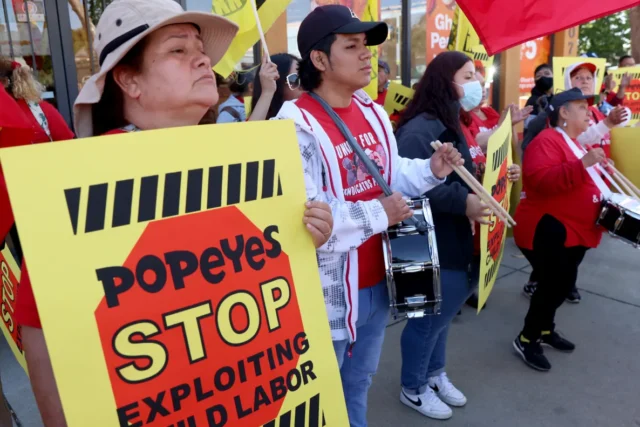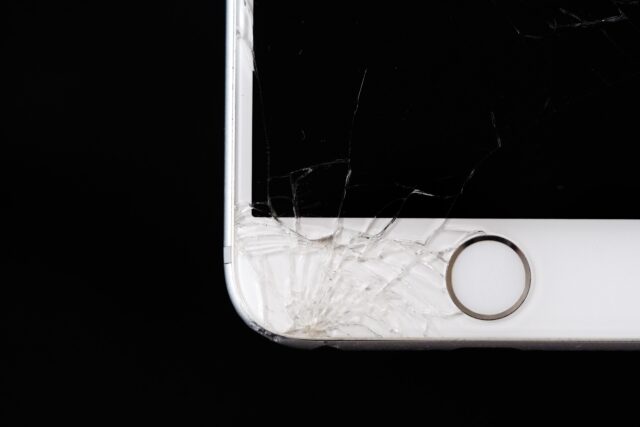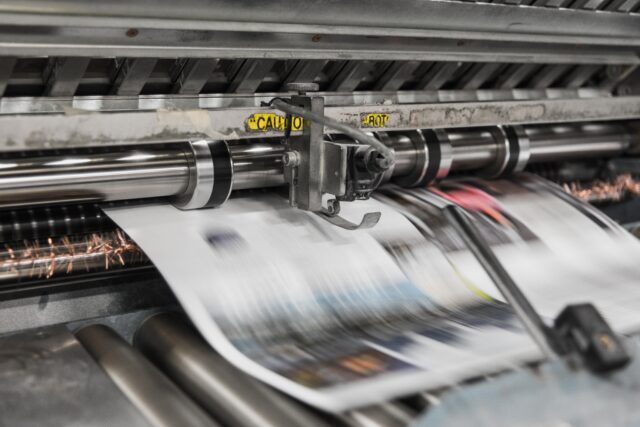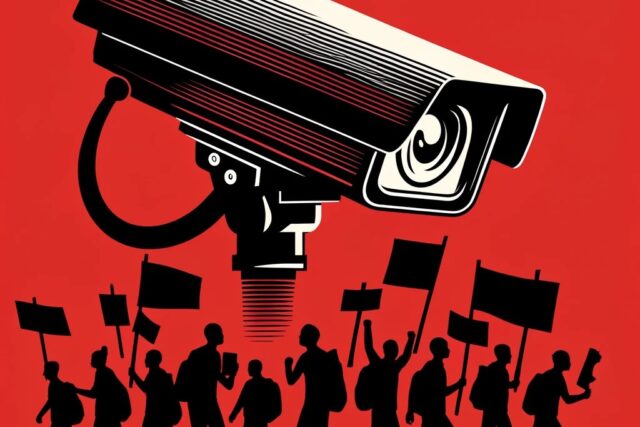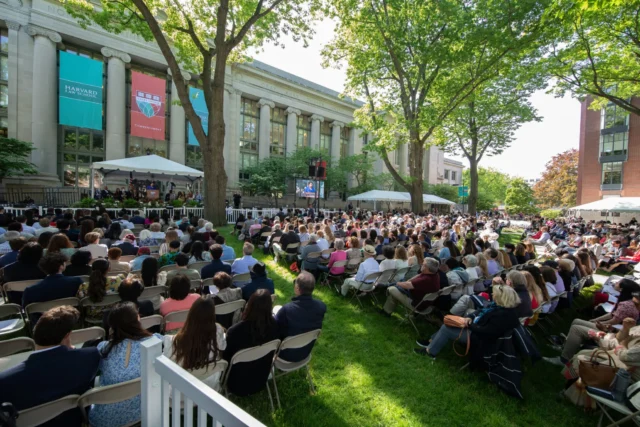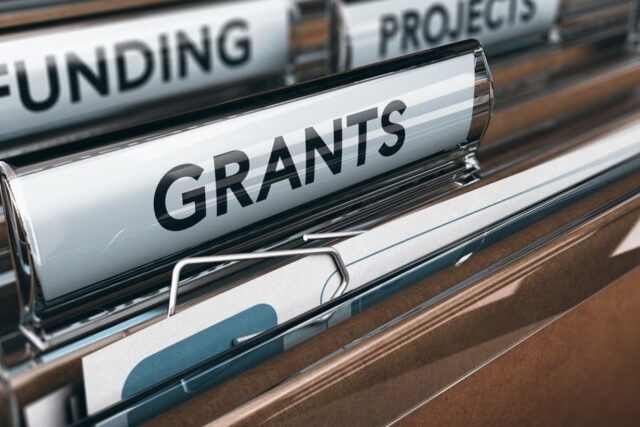The United States is experiencing a human rights crisis. Approximately two million people are living behind bars (a four-fold increase since the 1970s), with people of color accounting for nearly 70% of this number and with the vast majority incarcerated due to issues of poverty. We have the highest incarceration rate of any country in the world that continues to increase, even though our crime rates have fallen over the past three decades. States and the federal government are creating more and more crimes each year, and giving the police more power to presume wrongdoing. This is all true even though many of the original rights granted to the people in the Constitution, like counsel, due process, and a fair trial, exist for one reason: to protect you when the government believes you have done something wrong.
This article cannot appropriately describe the horrors of incarceration, nor adequately convey the United States’ addiction to punishment. But incarceration causes immense suffering for individuals, placing them at great risk of violence and worsening mental health outcomes, in addition to all of the collateral consequences to employment and housing. It also greatly affects their families and communities, destabilizing the “informal networks” that actually serve to make communities safer, unlike incarceration itself. And for the three million others who are not sentenced to time in prison but are still under state control, the conviction itself can trap people in poverty for decades. The United States spends billions of dollars each year to maintain these norms, and to keep people in cages.
This leaves public defenders with the knowledge that reducing mass incarceration falls on their shoulders, in the courtroom of each individual case. They also are acutely aware that they do not have the time or resources to give each client a real shot, and that their presence in the courtroom may very well be “legitimizing the status quo.” But what can they do? Traditional policy and litigation efforts are not working to address the back-end system of incarceration. Policy wins are being undone by states embracing a tough-on-crime mentality, and Congress has made it incredibly difficult for people who are incarcerated to bring lawsuits about their conditions. The conversation about access to criminal “justice,” then, tends to fall on the front end, and asking whether individuals received counsel. Given caseloads and the need for indigent defense, we know that public defenders cannot meet the demands of their clients. But the standard for an ineffective assistance of counsel claim is very high, and case-by-case adjudications of systemwide right to counsel deficiencies are not working.
This leaves public defenders with the option of coordinating power through labor efforts. But successful examples in the criminal defense space are rare, in part because many states are not unionized, and some jurisdictions operate mainly with part-time contract attorneys. It would take an experienced organization to lead any meaningful effort.
“The stakes are high. We must come together. We must put aside our differences. We must unite for the working class, not only for our own families and communities but for future generations. This is what ALAA UAW Local 2325 has done for decades. We fight for justice, we fight for social justice, and we fight for our own liberation as the working class.”
-Bronx Defenders attorney Sophia Gurulé
Since New York does not have a statewide public defender system, its biggest city is, on its face, an unlikely candidate to challenge the system through coordinated contract negotiations. The Legal Aid Society (LAS) is the largest of the organizations that provide defense services and operates in all five of NYC’s boroughs, but does so alongside five other organizations — Bronx Defenders, Neighborhood Defender Services, New York County Defender Services, Brooklyn Defenders, and Queens Defenders — who all maintain their own budgets and contracts.
Enter ALAA. ALAA is the oldest union of attorneys and legal advocates in the country, and brings together over 3,000 public interest attorneys and advocates in the New York City Metro Area, including five of the six public defender organizations. It has a dual mission of serving both its members and the indigent clients its members represent. As stated by ALAA, its mission is, in part, to “advocate through political outreach for the advancement of the interests of our membership, our clients and of poor and working people in general.”
ALAA has a deep history of engaging with and responding to systemic issues. It was born from the criminal procedure battles ignited by Gideon v. Wainwright, which decided in 1963 that the guarantee of counsel by the state is a fundamental right. At the time, the Legal Aid Society was the only public defender organization in the city. To respond to the massive increase in indigent representation demand, LAS expanded to become both the largest and the oldest organization of its kind, hiring numbers of young attorneys who brought an ethos of organized power from the Civil Rights movement and demanded a workplace that would allow them to uphold their duties to their clients. ALAA was formed and recognized in 1969, and LAS, with the support of their clients, went on strike many times in the years that followed to support better employee contracts. Since LAS was the only public defender organization, these strikes had immense power to shut down the entire system.
Over the past 30 years, ALAA has been building back, creating its vision, and organizing new offices
In 1994, Rudy Guiliani, using tools he may have acquired from Reagan’s union-busting efforts, announced plans to blacklist striking workers and open the process for new public defender agencies to compete with LAS for legal contracts with the city. He did so as an anti-striking measure: he wanted to make sure that the city would “no longer be at the mercy of one group that could decide in the future to go out and strike.” New organizations crossed the picket line to submit contract bids to serve as the city’s public defenders, leading to the borough-based organizations we now know as organizations like Bronx Defenders and Brooklyn Defender Services.
Over the past 30 years, ALAA has been building back, creating its vision, and organizing new offices. In the last eight years alone, they brought an incredible 25 organizations into ALAA’s membership. Expanding ALAA to new organizations doesn’t just show commitment to ALAA’s cause — it drastically increases the union’s ability to collectively make new demands of the city. Specifically, it enables more organizations “to work together to try and increase state and city funding for public defenders instead of competing against each other for the same pot of money,” as one UAW executive explained in an interview.
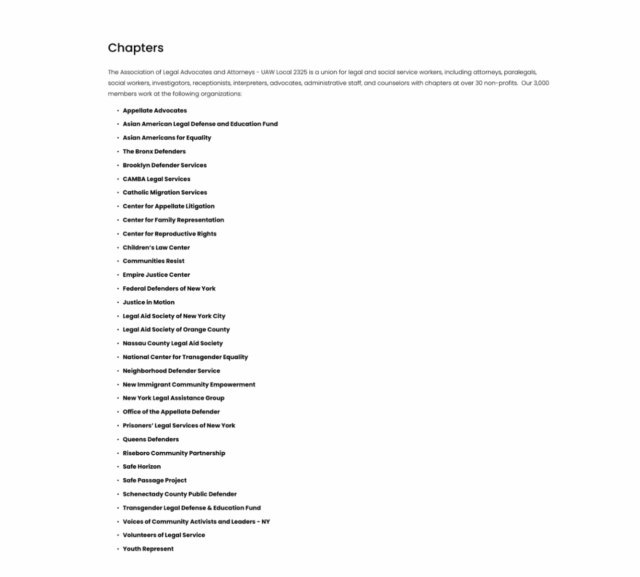
The organizations ALAA lists on its website as its chapters.
In June 2024, ALAA 2325 hosted the local’s first-ever convention consolidating that power, and deciding what the union would do with it. Union members officially voted to deploy a sectoral bargaining strategy. It was at this time, a former ALAA member explained to me, that ALAA also picked a date far enough out to allow the organizations with existing contracts one more renewal to standardize expiration dates: June 30, 2025.
By having contracts expire simultaneously, UAW leader Vail Kohnert-Yount explained in an article, ALAA “believes it will be more empowered to extract concessions from management and to secure increased funding from city and state governments.” This means that the city has until June 30 to come to the table with contracts that the union agrees with, or the workers can agree to collectively withhold their labor. As explained by Leswing, this evens the power imbalance typically found between employers and employees: “Withholding labor is the only way for workers to demand that their employer come to the bargaining table and negotiate the terms of their employment.” And history has seen this strategy work. Last year, sectoral bargaining plus a six-week strike won big raises for workers at the Big Three American automakers, Ford, General Motors, and Stellantis.
But ALAA’s sectoral bargaining is about more than just wages. Yes, it seems to get the working conditions that NYC’s attorneys deserve, but it also is inherently client-centered, seeking a change in funding for the whole industry and improving the representation that clients receive. Ultimately, it rests on the belief that better working conditions for working-class attorneys means better fights on behalf of the working-class people they serve in the courts every day.
“The powers that be have us all on the brink of societal collapse. The bottom appears to be falling out. But something had to give. We have to give. As organized workers, as organized legal services workers and advocates, we’re ready to do what needs to be done for our communities. We fight every day in these … courtrooms for human dignity and justice. This is what we do all day every day. So what we are gearing up for in this moment, for sectoral bargaining, is defending not only our clients and the conditions that hurt our clients in the first place, but we are defending ourselves.”
-Bronx Defenders attorney Sophia Gurulé
“It’s never an easy decision for a worker to strike,” Sophia Leswing, a former organizer at the Service Employees International Union (SEIU) 32BJ in NYC and current student at Harvard Law School, shared. “[Public defenders] definitely are each wrestling with the tough moral choice, but they think that in the long run, it will benefit their clients.”
To understand why New York City’s public defenders are considering a strike, you have to understand the insurmountable math of their daily lives. Few jobs demand more of a person — emotionally, mentally, and ethically —than public defense. The American Bar Association recommends that public defenders take on no more than 150 felony cases per year. That number has been criticized as too high, and that’s if the attorneys take on no misdemeanor, mental health, juvenile, or appeals cases. In big cities like New York City, attorneys routinely exceed that, managing at least three times the recommended number.
Public defenders are typically appointed (if the charge is eligible) at an arraignment, which is a proceeding after an arrest where a judge informs an individual what charges they are facing. Public defenders then represent that individual for the remainder of their case, facing the task of holding the state to its requirement to prove a case beyond all reasonable doubt– arguing to remove illegally-obtained evidence from the record, pointing out lies in police reports, sorting through hundreds of pages of government documents to try to find evidence that might prove someone’s innocence, and preparing for days-long trials, all while maintaining plea bargain negotiations with a prosecutor. The stakes are high. Unlike other jobs, one mistake could cost a person their life as they know it.
Under these caseloads, there are simply not enough hours in a day to give people the defense they deserve for misdemeanors, let alone felonies.
The Supreme Court has found that the Constitution guarantees the right to a public defender, because lawyers are essential to a fair trial, and fair trials are required to find someone guilty and authorize a judge imposing a sentence. But the Constitution does not guarantee that the public defender will have the time, energy, mental health, or experience to provide what we would consider a good defense.
Under these caseloads, there are simply not enough hours in a day to give people the defense they deserve for misdemeanors, let alone felonies. When an attorney is drowning in cases, something must give. It might be the visit to a client in jail to show them the boxes of discovery the attorney just received, so that they might understand their chances at the trial scheduled for the following week (likely already way too close to trial to fully review). It might be the time to file a motion to get rid of drug residue found in a stop and frisk in which a police officer stopped a client just because they were Black and looked nervous. It might be the time to track down a key witness to corroborate the client’s story, or to get family members on the phone to try to get letters of support for a sentencing.
Other math happens when public defenders get home. As much as they have committed their lives to thinking of others, public defenders also have to pay their bills. As one UAW member shared with me on background, barriers to being able to provide excellent services are inextricably connected to student debt: “Public defender and tenant defense and immigration defense services are chronically underfunded, and they’re not getting better. They ask what they can do to get more funding for their services because their services are connected to student debt. These jobs barely pay, especially for the city, and it is incredibly hard for people who come from these communities to actually serve, especially because at the same time of defunding, they are also cutting the public service loan forgiveness program that a lot of people relied on.”
New York City’s public defender system is shaped not just by policy decisions, but by the economic, political, and corporate power that shapes the rest of America.
Our Bill of Rights is, in many ways, a criminal procedure document. Our promises of justice cannot be met without public defenders, and public defenders cannot serve without getting a law degree. But law degrees are incredibly expensive. In New York City, where the average salary needed to live comfortably is more than $138,000, first-year law graduates begin with only $74,000 at these legal services organizations — and $130,000 of debt. That is barely enough to pay rent, let alone make student loan payments, support relatives, or have joyful moments that are necessary to give clients dealing with traumatic events such as domestic violence, homelessness, and sexual abuse the attention they deserve. Some of them have to work multiple jobs, just to make ends meet.
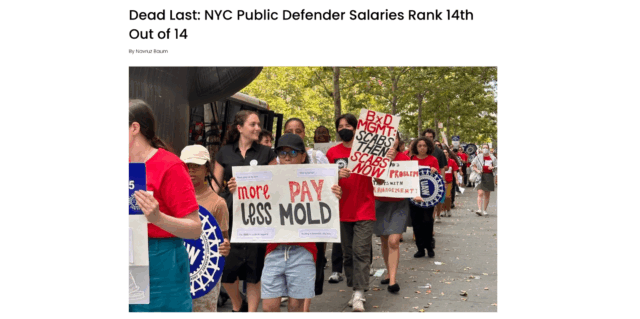
ALAA’s online newspaper, The ALAA Organizer, posts an artlce about NYC public defender salaries ranking last out of 14 cities.
During the pandemic, New York City started to expedite gun possession cases, fast-tracking serious charges through an already overwhelmed system. A mistake could result in clients facing years behind bars. Hundreds left New York City public defender offices, no longer financially able to continue the fight, no matter how much they wanted to.
That’s not a failure of commitment. That’s a failure of the system.
![scales - Logo for The [F]law](https://theflaw.org/wp-content/uploads/2022/07/flaw_scale_divider.png)
New York City’s public defender system is shaped not just by policy decisions, but by the economic, political, and corporate power that shapes the rest of America. The public defender organizations exist to serve the most vulnerable, but they don’t operate outside the reach of capitalism.
ALAA’s story is one of pushback against unions and their ability to strike for better contracts. But political elites argued that this resistance was not against organizing itself; it was simply promoting the market capitalism strategies that would lead to more efficient outcomes, for the city and for clients. But NYC’s bidding process has not improved with more competition. It has merely led to more competition for a smaller pool of money, keeping working conditions insufficient and clients competing for the time of fewer full-time attorneys.
Public defenders are not afraid of hard work. They sign up to fight for the people from whom corporations profit by convincing others that they should be behind bars; for the people deemed expendable or illegal; for people abandoned by centuries of violence; for people of color. But the conditions under which they do this work make this task impossible, and they are human too.
Efficiency has always justified leaving people behind. What has been efficient for the ruling class across America’s history is to maintain the structural abandonment of working-class people of color. It is no secret that criminalization and the revolving door of mass incarceration has existed to create profits, from convict leasing to private probation and fines and fees. Criminalization insulates the wealthy and renders the clients of underserved lawyers vulnerable. This causes a crisis in big cities like New York, where police are emboldened to violently control poor people and the government has failed to help people meet the most basic of human needs. The people who are closest to this system — lawyers who are uniquely poised to call out human rights violations and to hold powers accountable –— are expected to not think of themselves as powerful, at risk of violating their ethical duties or appearing ungrateful for the opportunities they have had to join a so-called prestigious industry. The world has helped them, and they should distance themselves from being fighters from the working class. They should certainly avoid being a “nuisance” to wealthy elites.
As inequality increases, it becomes incredibly important that those in charge recognize that more resources are needed to fight for indigent clients. But, while the public defender offices fight for the people, their foundations are built on contracts, budget lines, and approval from board members who often have little stake in the communities these lawyers serve.
Legal services are funded by taxpayers, but corporate elites run the boards of many of New York City’s legal providers, including LAS, NYLAG, Brooklyn Defender Services, Bronx Defenders, and Neighborhood Defender Service. One member of LAS’s Board has played a direct role in criminalizing pro-Palestine student activism and has “bragged about locking down the campus, banning student groups, escalating police presence, and calling in the FBI.” One member of NYLAG’s board has helped to create the foreclosure crisis, where Americans saw their homes seized. They and many other board members have plagued legal services organizations with visions of the financial austerity that have led workers to have raises below the rate of inflation, inadequate benefits, and unsustainable caseloads. To control workers, they have “banned emails discussing Black history, fought against gender justice, and turned a blind eye to police brutality,” in addition to “publicly attack[ing] their workers for their union statements, ignor[ing] worker calls to stop participating in events with ICE, and shar[ing] employee data with the agency.”
It’s easy to forget that nonprofits, too, are shaped by power. Combined with over-policing and mass incarceration, difficult conditions are created for attorneys to do their work in a way that truly fights for the working class.
This is why collective bargaining is so necessary. ALAA doesn’t necessarily have to identify the exact systemic forces at play when it makes its demands. Its members just have to decide what conditions will sufficiently counteract them.
![scales - Logo for The [F]law](https://theflaw.org/wp-content/uploads/2022/07/flaw_scale_divider.png)
Despite labor unions enjoying a moment of stronger public approval than usual, this approval doesn’t necessarily extend automatically to public defenders. Employers and judges argue that public defenders, unlike health care, nonprofit, higher education, and manufacturing workers, have an ethical duty not to strike, even if they are unionized. The threat of shutting down the courts is different from the threat of fewer options for morning coffee or longer waits for movie releases. If the decision regarding whether to strike considers both the risks to the public and the potential for a protection of worker dignity, the calculus for workers at a large, profit-motivated organization is easy. When the clients are fellow members of the working class facing state-sanctioned violence, the potential for protection of worker dignity seems not worth the risk, even with the comprehensive steps public defenders offices take to avoid jeopardizing their clients.
But people’s disbelief at legal services workers striking betrays a dangerous assumption — that guaranteeing the mere presence of a lawyer (in theory) is enough to meet Constitutional demands. We can sleep peacefully at night, we want to believe, because professionals are taking what they have learned from class, student practice organizations, and bar exam preparation and making sure that every judge and jury carefully applies the law before deciding to place someone in a cage. People who are worried about the human rights crisis of the United States continuing slavery by another name at the highest rates in the entire world and ripping apart Black families think state-sanctioned violence is not okay, but are comforted by the idea of the existence of a zealous advocate. People who think state-sanctioned violence is okay are glad that someone with a Juris Doctor is there to legitimize the proceedings.
Public defenders are not afraid of hard work. They sign up to fight for the people from whom corporations profit by convincing others that they should be behind bars; for the people deemed expendable or illegal; for people abandoned by centuries of violence; for people of color. But the conditions under which they do this work make this task impossible, and they are human too.
ALAA’s sectoral bargaining, supported by the threat of a strike, will, hopefully, will lead to more people able to stay in the career they went to law school for. And it, most importantly, addresses what the union has called the ethical duty to strike: “[The duty of public defenders] is not to simply sign retainers with empty promises of competent representation. Our ethical duty is to transform our sector so that it provides competent representation to every client, present and future.”


![scales - Logo for The [F]law](https://theflaw.org/wp-content/uploads/2022/07/flaw_scale_divider.png)
![[F]law School Episode 13: The Migrant Trap](https://theflaw.org/wp-content/uploads/2025/03/Drury_FB2-e1742192209662-640x427.png)
